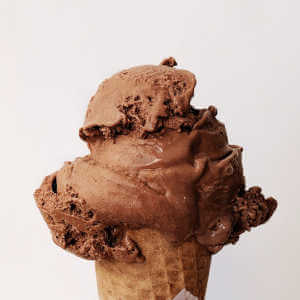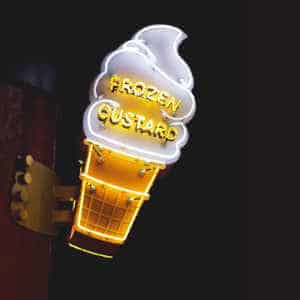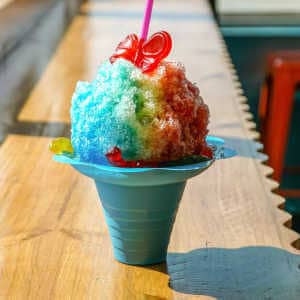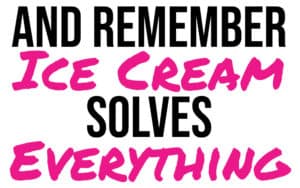What are the different types of frozen desserts? In this post, I want to share with you all the different types of frozen desserts you can make in your ice cream business. It is estimated that the World’s annual consumption of ice cream is around 15.4 billion liters. 29% of this is just plain old vanilla ice cream. In the US alone we each consume around 23 gallons of ice cream a year. But when it comes to ice cream, what is your go-to. Do you love gelato or how about a refreshing sorbet? Wait, what about a frozen custard or snow cone. Or is a dairy-free option your thing?
If you plan on starting an ice cream business, you need to know what type of ice cream you are going to make. In this post, I want to share with you all the different styles of ice cream you could base your ice cream business around.
What Are The Types Of Ice Cream And Frozen Desserts?
As a general rule, there are 14 main categories of frozen desserts. The most well-known categories are Traditional Ice Cream, Gelato, and Frozen Yogurt. Frozen dessert styles will vary depending on the base. Most frozen desserts are made using a common base which is then flavored. The main categories are:
- Traditional ice cream
- Gelato
- Frozen Custard
- Italian Ices
- Granitas
- Sorbet
- Semifreddo
- Philadelphia Ices
- Non-Dairy Ice Cream
- Vegan Ice Cream
- Frozen Yogurt
- Sherbet
- Snow Cone / Hawaiian Ice
- Rolled Ice Cream
I will go through each type in detail below. But first, we need to go over some ice cream science.

Ice Cream Science 101
At this point, I want to quickly talk about the science behind ice cream (in the simplest way possible). When it comes to the science of ice cream making you need to understand just two things – ice crystals (and how they are formed) and “overrun”.
Ice Crystals
Everything to do with ice cream and frozen desserts have to do with ice crystals. To make smooth ice cream with a creamy mouth full you need to create an ice cream that has lots of the smallest ice crystals possible. The larger the ice crystals that are formed during the freezing the less creamy your ice cream will be.
So, how do you form small ice crystals?
The key to forming small ice crystals is your recipe and how quickly you can freeze your ice cream mixture.
Your Ice Cream Recipe
Let’s start with your ice cream recipe. You need to have an ice cream recipe that has enough molecules to get in the way of water crystals forming. Therefore milkfat, milk solids, and sugars are so important in ice cream recipes. By adding these in you are adding substances that can get in between water molecules and prevent them from joining together to create large ice crystals.
This is one of the reasons that sorbets are so different in texture from ice cream – because they are water-based. You need to add a lot of sugar to stop the water from forming big ice crystals when freezing.
How Quickly You Freeze Your Ice Cream
How quickly you freeze your ice cream is the other side of the equation. The quicker you can freeze the ice cream and churn it, the smaller the ice crystals will be. This is because the water molecules will not have a lot of time to form into larger crystals.
This is also why ice creams like Nitrogen ice cream can create super creamy textured ice cream in minutes. It freezes the ice cream mixture more quickly than any traditional batch freezer can.
Overrun
At this point, it is worth talking about “Overrun”.
Overrun is the amount of air that you add to your ice cream mixture during the batch freezing process. The more air you can add, the greater the volume of your ice cream will be.
Overrun is what makes the ice cream business model so profitable. Why? Well, because you can freeze a 1 kg mixture of ice cream and produce 1.5 kg (50% overrun) of final frozen ice cream. Overrun can also help create a lighter and smoother texture to your ice cream.
However, too much can cause it to melt quicker and lack flavor. Why? Because there is more air in it. The higher the quality of the ice cream, the less overrun it will have and the more expensive it will be.
How Much Overrun Can I Add?
Controlling how much overrun you can get into your ice cream is extremely difficult. There isn’t a button on your batch freeze which you can set to get more overrun. The only things in your control are the beater speed and your recipe. Therefore, a lot of people will add thickeners, stabilizers, and emulsifiers to their ice creams – as they can all help achieve more overrun in recipes.
How much overrun you can achieve is more of an art than a science. Also, as I mentioned the higher your overrun the less flavor and quality feel your ice cream is going to have. Don’t believe me? Just go to the grocery store and buy a tub of cheap vanilla and then an expensive tub of vanilla and compare the difference.
You will be able to see what has a higher overrun by comparing the net weight with the volume of the ice cream on the front of the packaging.
How Do I Measure Overrun?
To measure overrun in your ice cream shop you will want to weigh your ice cream mixture just before it goes into the batch freezer. Make sure to weigh it in the same container as your tub your final frozen ice cream. Then measure it again once it comes out frozen and has been tubbed. The difference in weight will tell you how much the ice cream has increased in volume.
For example, a 1 kg mixture of ice cream coming out at 1.5kg will have an overrun of 50%.
Overrun doesn’t just apply to “ice cream” it also applies to every other frozen dessert type on the list so be sure to learn how it works.
Each Type of Frozen Dessert Explained
Types of Frozen Dessert – Explained

1. Traditional Ice Cream
The first thing to know about ice cream is that not anything can be called an “ice cream”. What constitutes an ice cream is regulated by FDA rules. According to the FDA an ice cream is:
- is a food produced by freezing, while stirring, a pasteurized mix consisting of one or more of the optional dairy ingredients specified…
Also, to be called an “Ice Cream” it must:
- contains a minimum of 10% dairy milkfat
- have no more than 100% overrun and weighs no less than 4.5 lbs. per gallon.
What Does This Mean For Me?
If you want to be able to call yourself an “ice cream” shop, then you need to make ice cream in accordance with the above rules. Otherwise, I am afraid you will be a “frozen dessert” shop.
How is Ice Cream Made?
How is ice cream made? Ice cream is made by making a common dairy base. This is then flavored to produce different styles and varieties of flavors.
A traditional ice cream base will be made of milk, cream, sugar, and egg yolks. However, most commercial ice cream operations will opt for an eggless recipe involving milk, cream, milk solids, and sugars. Depending on the type of ice cream you want to make you may want to use emulsifiers and stabilizers. These can help create a creamier and more consistent base, but some people don’t like them.
Ice Cream Making Steps
Here are the steps for making traditional ice cream:
- Your ice cream mixture of milk, cream, milk solids, and sugars are whisked together to create your ice cream base.
- This is then pasteurized by heating to 82-85oC for a minimum of 15 sections and then cooled to kill any potentially harmful bacteria.
- Flavors are then added to create your desired flavor (vanilla bean pods, vanilla extract, etc).
- The mixture is then mixed again and poured into a batch freezer. A batch freezer freezes and beats the mixture at the same time. This whips in ice while the ice cream is freezing to create the soft and creamy ice cream texture.
- The ice cream is extracted and packaged.
2. Gelato
What is the difference between gelato and ice cream? That is a good question.
Gelato is made from similar ingredients as ice cream – milk, cream, and sugar (no eggs). However, there are two key differences between gelato and ice cream.
- It uses less cream and more milk in its recipe; and
- It undergoes a much slower ice cream churning process.
When it comes to gelato you will want to turn the speed down on your batch freezer – all the way down. The slower your churn the less air that is added to the ice cream. The result is a low overrun frozen dessert which is much thicker and denser.
The making steps, however, remain like ice cream.

3. Frozen Custard
Frozen custard traditionally refers to ice cream bases that have the addition of egg yolks. If you are working in a higher-end restaurant kitchen that makes its own ice cream, then this is how you will make your ice cream.
The recipe for this type of frozen dessert also makes a traditional pudding custard which is why it is called a “Frozen Custard”. The result is usually a thicker and creamier textured ice cream. Ironically, the addition of egg yolk also helps the ice cream melt slower. The egg yolks act as natural emulsifiers which help bind water and fat droplets into ice crystals. This helps improve the structure of the ice cream and therefore slows its melting process.
4. Sorbet
Next on the list is the sorbet. Sorbets are water-based frozen desserts made of water and sugar (lots of sugar). These are then blended and flavored – usually with fruit flavors. Sorbets tend to work best with fruit flavors because a lot of fruits tend to be high in water content. This can affect dairy ice cream texture.
Also, a traditional dairy base can take away from fruit flavor profiles.
The key to creating an excellent sorbet is making sure you get your sugar to water ratio just right. Too much water and it will be too icy. Too much sugar and it will be too sweet and melt too quickly.
Sorbets will be fat-free, but high in sugar. They are also frozen in a batch freezer.

5. Italian Ices
What’s the difference between Italian Ice and sorbet? It all comes to the making process. This is because when it comes to recipes there isn’t much difference. They are both made of water, sugar, and flavoring. However, with Italian Ice, the mixture is first frozen hard and then shaved. The shaved ice can be coarse or fine.
It can also be flavored after the ice is shaved or flavored before it is shaved.
There are a variety of different styles of shaved ice. These include:
- Italian Ices (finely shaved ice that is flavored either before or after shaving)
- Granita (coarse shaved ice)
- Philadelphia Ices (finer shaved ice that has been flavored before shaved and made using Philadelphian water)
- Shaved Ice (finer shaved ice that is then flavored)
- Snow Cones (a paper cup filled with crushed ice and flavored)
- Hawaiian Ices (finely shaved ice from a block of ice that is then flavored)
6. Sherbet
A sherbet is a form of lighter dairy ice cream. However, unlike ice cream is it made of milk, sugar, and egg whites. Also, buttermilk fat levels used then to be lower. This gives it a lighter and softer texture. You don’t tend to find sherbets as often available.
7. Frozen Yogurt
Frozen is a dairy milk mixture that has added probiotic cultures added to it. This type of frozen dessert can be made in a variety of ways – it can be mixed with an ice cream base or just from a yogurt base. It comes in three categories – soft, hard, or mousse. The main difference between the serving temperature.
Frozen yogurts tend to be lower in fat (because they don’t use buttermilk fats). They also can be higher in sugar and will normally need stabilizers and emulsifiers to help contain whipped air during the freezing process.
Traditionally, frozen yogurt is soft in the form of soft serve. This is where the frozen yogurt is frozen and then immediately serve to the customer. Soft serve will be served at higher temperatures of around 20oF.
8. Non-Dairy Frozen Desserts
Non-Dairy Frozen Desserts are “ice cream” like desserts that are made without any dairy. They legally can’t be called “ice cream” hence non-dairy frozen desserts. Most commonly they will be made by using an alternative to dairy, such as nut milk (almond, oat, cashew, coconut milk, etc.) and mixing these with sugar, flavorings, and stabilizers. Often water is added to lower the cost as well.
This mixture is then frozen in a batch freezer like ice cream.
These can be the hardest to get right in terms of the recipe. Because of the lack of natural fats, it makes a lot of milk alternatives harder to get a creamier consistency. Therefore, stabilizers and thickeners are often added.
The best dairy alternatives are those with high naturally occurring fats – for example, coconut cream. The downside is that you can end up with a very coconutty tasting ice cream.
9. Vegan Frozen Desserts
It is worth noting that just because something is dairy-free does not make it vegan. Vegan frozen desserts are made like Non-Dairy Desserts but will have a completely vegan ingredient list. If you plan on running an ice cream business, make sure to have some dairy-free and vegan options available.
10. Semifreddo
Last to mention on the list is Semifreddo. Translated Semifreddo means “half-frozen” and refers to a mousse that is then frozen. Made from sugar, heavy cream, and egg yolks semifreddo is whipped for long periods of time to create an extremely aerated and light mixture. This mixture is then frozen to create a semifreddo. What you are essentially doing is creating ice cream from whipped cream.
11. Rolled Ice Cream
Rolled ice cream is a popular ice cream concept that originated in Thailand. Rolled ice cream is made by hand mixing and scraping an “ice cream” mixture on a frozen plate using a pair of metal spatulas. It has less air than regular ice cream and often contains less sugar. The price point of rolled ice cream is higher than regular ice cream due to the staff costs required to make it fresh to order. If you want to learn more above rolled ice cream I dedicated a whole post to it here: Everything You Need To Know About Rolled Ice Cream.

The Final Lick – What Are the Different Types of Ice Cream
Okay, so you decided to open an ice cream business – but what exact type of ice cream or frozen dessert are you going to make. There are businesses in the ice cream market that focus on just making one style. Others make a variety of styles.
The type of ice cream you choose to make can really affect your business model and who you target your product to. On top of this, you have to decide on the quality of your ice cream. Are you going to be making low-overrun ice cream with quality ingredients – and charge a higher price – or make cheaper high overrun ice cream that pleases the masses.
Are you going to make super creamy and dense ice cream with high milkfat? Or how about the great shaved ice in your area. All these business models can and do work.
Personally, I like to focus on a specific category and then just do it very well. One of my most successful ice cream businesses is a vegan plant-based “ice cream” that offers just 7 flavors at any one time. That’s right just 7 flavors – and no more. We focus hard on making superior plant-based ice cream you just can’t find anywhere else.

Time To Learn Some More
Want to learn more on your path to ice cream entrepreneur success. Then check out some of my other articles.
- What Are the Challenges In An Ice Cream Business
- How Do I Start My Own Ice Cream Business
- Ice Cream Shop Profits – How To Run A Profitable Ice Cream Shop
- How Much Does It Cost To Start An Ice Cream Truck
- How Much Does It Cost To Start An Ice Cream Shop
- Ice Cream Shop Accounting – Everything You Need To Know
- Can I Make Ice Cream At Home And Sell It
- Is Vegan Ice Cream Profitable
- What Equipment Do I Need For My Ice Cream Truck
- How To Pick A Generator For Your Ice Cream Truck
- How Profitable Is An Ice Cream Truck?
- Everything You Need To Know About Working In An Ice Cream Shop
- Everything You Need to Know About Writing an Ice Cream Business Plan
- Everything You Need To Know About Rolled Ice Cream
- Everything You Need To Know About Soft Serve Ice Cream
- Vegan “Ice Cream”
- Everything You Need To Know About Batch Freezers
- What Equipment Do You Need For An Ice Cream Shop
- What Supplies Do You Need For An Ice Cream Shop
- What Is The Best Location For An Ice Cream Shop
- How To Open An Ice Cream Shop
- How To Start An Ice Cream Truck
- Do Ice Cream Shops Make Money in the Winter
- How To Make An Ice Cream Shop Stand Out
- How Do You Become An Ice Cream Distributor
- Everything You Need To Know About Ice Cream Delivery Apps
- Everything You Need To Know About Gluten-Free Ice Cream and Toppings
- What is the Mark-Up on Ice Cream?
- What Scoopers Do Ice Cream Shops Use?
- What Are the Best Toppings and Sauces for Ice Cream?


